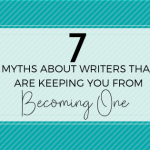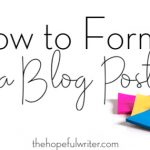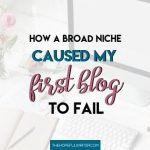There were so many mornings in college I’d wake up at 3 or 4 a.m. the day an essay was due and start from writing right then. No prep, no draft.
After a hundred years of writing, I’ve finally learned that this practice makes writing a pain. It makes it frantic, excruciating, and less quality.
The trick to creating quality content (well, one of them)?
Preparing.
You might resist it, thinking you don’t have the time to prepare before you write. This mindset plagued me for years, but I’ve learned there are many benefits to making a plan before you write:
Your writing will be of better quality. When you prepare for whatever content you’re creating, whether it’s a blog post, an essay, or a book, you’re likely to have more helpful resources for your readers. Your words will be well-crafted, which in turn makes your stuff easier and more enjoyable to read.
You can write quicker. Writing will be a breeze (or more of a breeze) when all of the information you need is right in front of you. With an outline, you’ll have a map of what you’re going to write, so you can spend less time staring at the screen without any clue what to say next.
Editing will take less time. Proofreading your posts before you publish them is vital, but it will take less time if you prepare your writing ahead of time. Your content will be well-crafted, and then take less time to fix.
Your blog posts are more likely to answer your readers’ needs. Successful blogs serve a purpose. When you brainstorm and outline your blog posts, you can be sure you’re not just writing to get something on the page. You can ensure that each blog post answers a question or fulfills a need for your audience.

My Process
Here’s my simple process for how I prepare for blog posts. This process could also work for other types of writing, such as school essays, copywriting projects, and more.
Brainstorming Big Ideas
When my bank of blog post ideas is running low, I have a brainstorming session to fill it up again. A big brainstorming session could happen every month or more often—for me, it’s as needed.
I begin the process of preparing for writing by sitting down and writing down as many blog post ideas I can think of.
I write down a working title, but if I have more specific ideas for a post, that goes on the paper too. I like to brainstorm a lot of post ideas at one time so that I don’t feel like I’m always trying to come up with ideas.
After this process, I’ll look at my list of blog post ideas each week and choose two to write.
Sometimes I use strategy for my planning, like asking whether something seasonal is coming up that I should address. However, I also like to have the freedom of posting what I feel like my audience needs or wants at that time. For example, I recently got an email from one of my readers that gave me an idea for a post I want to write as soon as possible. If you have a strategy, don’t let it limit you when it could be helpful to change things up.
Brainstorming My Blog Posts
Brainstorming a blog post is messy for me. I write out my most important ideas, include any links I’ll add, and anything other information I don’t want to forget as I’m writing.
Although it’s messy, brainstorming is where my blog posts come together. As I jot down ideas of information to include in my post, I start to see how I want to outline my blog post.
If you don’t usually brainstorm, try it! Here’s a free downloadable Blog Writing Prep Packet (with a fillable PDF so you can type in it). In the packet, I added a bunch of questions to help with the brainstorming process.
Outlining
The next step for blog writing prep is outlining. Like I said, outlining and I are just barely getting acquainted. It’s like the cool new friend I’m excited about, but still a little shy around.
My outlines are usually pretty small, like this:
Writing Prep (Working Title)
Intro
Main Section:
Benefits of Preparing for Writing
• Quicker writing
• Better quality writing
• Know the purpose of the blog post
My Process
• Brainstorming Post Ideas
• Brainstorming Blog Posts
• Outlining
• Researching
Conclusion
CTA – Download printable
If I have specific ideas I want to include, I’ll jot them down under the subpoints to guarantee I don’t forget what I want to say.
Research
You may not always need to research for your blog posts, but if you do, make sure it happens before you start writing. Trying to research during your writing process will slow things down to a sloth-like pace. I know because I did this too many times as a freelance writer.
When researching, I copy the most helpful material I find and paste it under the relevant section in my outline. It’s okay to copy and paste a lot of information—you’ll cut it down later.
Be sure to keep track of where you find information. Keep the URLs so you can link back to other websites or give credit to another author or site.
I try to make my research quick. As a freelance writer, I was paid by the page, so I didn’t want to take too much of my time finding information. This habit has been helpful as a blogger because I have a lot of things I need to take care of for my website.
Your posts should be valuable and full of helpful information, but you can research effectively without taking hours doing it.
If your blog content is less than stellar, if you’re sick of staring at a blank screen and not knowing what to write next, or if you’re tired of feeling like a hot mess when you write, try preparing ahead of time.
To help make your process even more of a breeze, I’ve created a Blog Writing Prep Packet. Sign up below for your free download.







Great post! Outline really helps me too! I use a template and the upfront work helps me keep track of keywords and makes the actual writing part so much easier.
Thanks, Laneic! Yes, I feel like it’s so easy to get distracted, so a template is an awesome idea!